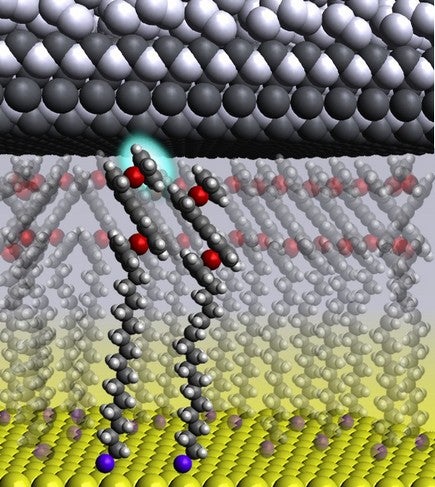Molecular diodes with rectification ratio exceeding 100k
July 04, 20174 Jul 2017. NUS scientists have constructed a molecular diode with a rectification ratio as good as silicon based ones.
Diodes are a key component in a broad range of electronic applications. They allow electric currents to flow only in a single direction around an electrical circuit. Prof Christian NIJHUIS from the Department of Chemistry, NUS and his research team, in collaboration with Dr Damien THOMPSON (University of Limerick) and Prof Enrique DEL BARCO (University of Central Florida), have fabricated molecular diodes with a rectification ratio (the ratio between the forward and reverse current) of nearly one million. The rectification ratio is a measure of the switching performance of the device. Although the value is similar to that of conventional diodes, it is achieved at much smaller physical dimensions. These diodes change the number of molecules contributing to charge transport only in forward bias but not in the opposite direction due to electrostatic switching. This breakthrough represents another step towards realising nano-electronic devices based on molecular systems.
This new molecular diode is based on self-assembled monolayers with redox-active ferrocenyl termini (a molecular compound). It has a rectification ratio of up to 6.3 × 105, comparable to silicon-based diodes. The new operating mechanism involves electrostatic switching of the molecule-electrode interaction. At forward bias, the positively charged ferrocenyl units interact strongly with the negatively charged top electrode. In reverse bias, the same ferrocenyl units are neutral and the interaction with the top electrode is weak. The researchers have successfully observed this switching behaviour in real time and verified it through molecular dynamics simulations.
Since the theoretical conception of molecular diodes 40 years ago, rectification ratios have remained low when compared to their silicon-based counterparts. The major reason is that molecular diodes operating in the tunnelling regime are intrinsically limited to a maximum rectification ratio (R) of about 103 (Landauer limit). Therefore, to enhance the rectification ratio to values comparable to that of conventional diodes (R > 105), alternative rectification mechanisms have to be developed.
The research team found that molecules can be charged inside the molecular junction. This then alters the molecule-electrode interaction due to the electrostatic interactions between them. By exploiting these electrostatic interactions, the researchers were able to increase the molecule-electrode interaction selectively in the forward bias condition, which resulted in superior device performance.
The work provides new ways to design molecular diodes that may find potential applications in ultra-high speed electronics or in nanoscale devices, where components need to be extremely small. Prof Nijhuis said, “This new mechanism of bias induced electrostatic switching between the molecule and the electrode can be seen as the molecular analogue of nano/ micro-electromechanical systems. The principle could be extended to other types of molecular electronic devices. By treating them as dynamic rather than static devices, it could open up new ways of designing molecular junctions.”

Figure shows the schematic illustration of the molecular diode where the molecules are standing on a gold bottom-electrode (yellow) and in contact with the top-electrode (grey and black spheres). In the foreground are two molecules: one is charged and conducts electricity, the other is neutral and does not conduct electricity. [Image credit: Harshini Venkata ANNADATA]
Reference
Chen XP; Max R; Yuan L; Du W; Damien T; Enrique B; Christian N*, “Molecular Diodes with Rectification Ratios Exceeding 105 Driven by Electrostatic Interactions” NATURE NANOTECHNOLOGY DOI: 10.1038/nnano.2017.110.


